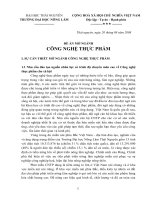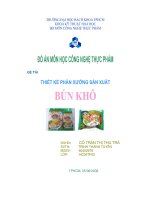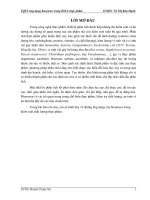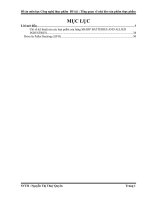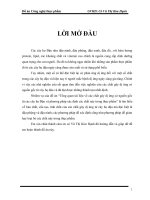Đáp án Tiếng Anh Công nghệ thực phẩm VNUA
Bạn đang xem bản rút gọn của tài liệu. Xem và tải ngay bản đầy đủ của tài liệu tại đây (39.69 KB, 4 trang )
TIẾNG ANH CHUYÊN NGÀNH CNTP
Question 1:
1.
What is cleaning? Give examples
- Cleaning is the unit operation in which contaminating materials are
remove from food and separated to leave the surface of the food in the
suitable condition for furthur processing.
- Example: Peeling fruits and vegetables, skinning meat or descaling fish,
blanching.
2.
Name the kinds of cleaning and their main equipment?
- Cleaning is categorized into wet procedures and dry procedures.
- The main groups of equipment used for wet cleaning are: Spray washers
brush washer, drum or piston washers and flotation tanks. And for dry
cleaning are air classifiers, magnetic separations and separator based on
screening foods.
Question 2
1.
What is wet cleaning used for?
- Wet cleaning is used for removing soil from root crops or dust and
pesticide recidues from soft fruit or vegetables.
2.
What are the advantages of wet cleaning?
- Wet cleaning is more effective than dry methods for removing soil from
root crops or dust and pesticide residues from soft fruits or vegetables
- It is also dustless and causes less damage to foods than dry methods
- Different combinations of detergents and sterilant at different
temperatures allow flexibility in operation.
Question 3
1.
What are wet cleaning procedures used for?
- Wet cleaning is used for removing soil from root crops or dust and
pesticide recidues from soft fruit or vegetables
2.
What are the disadvantages of wet cleaning?
-
The use of warm cleaning water may accelerate chemical and microbial
spoilage
Wet procedures produce large volumes of effluent, often with
concentrations of dissolved and suspended solids.
There is then a requirement both to purchase clean water and to pay for
high effluent disposal charges
Question 4.
1.
-
What are dry cleaning procedures are used for?
Dry cleaning procedures are used for products that are smaller, have
greater mechanical strength and possess a lower moisture content (for
examples grain and nuts).
2.
-
The advantages of dry cleaning
After cleaning, the surfaces are dry, to aid preservation for further drying
Dry procedures generally invole smaller cheaper equipment than wet
procedures.
Plan cleaning is simpler and chemical and microbial deteriation of the
food is reduced.
-
Question 5
1.
What is dry cleaning procedures used for?
- Dry cleaning procedures are used for products that are smaller, have
greater mechanical strength and possess a lower moisture content (for
examples grain and nuts).
2.
The disavantages of dry cleaning
- Additional captital expenditure may be necessary to prevent the creation
of dust that not only creates a health hazard but also recontaminates the
products.
Question 6
1.
What are the extracted components (oils and juices) used for?
-
2.
Components are extracted from plant materials either for direct
comsption (for example fruit juices) or use in subsequent processing (for
example sugar and vegetable oils)
In fruits processing, how is the press achieved?
- In fruit processing, the press is achieved by the use of lower pressure and
fewer pressings.
It is also necessary to increase the pressure slowly to avoid the
formation of a dense impenetrable press cake, as the solid material is
easily deformed.
Question 7
1.
-
Two methods of oil extraction?
There are two methods of oil extraction: solvent extraction and
expression
2.
What factors influence the yield liquid from a press?
The factors that influence the yield liquid from a press include
-
The maturity and growth conditions of the raw material
The extent of disruption of cell structure
The rate of increase in pressure
The time of pressing and the thickness of the pressed solids
Question 8
1.
What is the size reduction in food processing?
- Size reduction is the unit operation in which the averge size of solids
pieces of food is reduced by the application of grinding, compression or
impact forces.
2.
What are the main benefits of size reduction?
Size reduction has the following benefits in food processing
- There is an increase in the surface area to volume ratio of the food which
increases the rate of drying, heating or cooling and improves the
efficiency and rate of extraction of soluble components.
-
When combined with screening, a pre-determined range of particle is
produced
A similar range of particle sizes allows more complete mixing of
ingredients.
Question 9
1.
2.
Definition of chilling?
- Chilling is the unit operation in which the teamperature of a food is
reduced to between -1oC and 8Oc
The advantages of chilling
- It is used to retard microbial spoilage, to prevent the growth of
pathogens, and to extend the shelf life of fresh and processed foods.
- It causes minimal changes to flavours and nutritional properties of
pathoens, and as a result, chilled foods are perceived by consumers as
being “healthy” and “fresh”.
Question 10
1.
Why is heat treatment are one of the most methods used n food
processing?
Because of the desirable effects on eating quality (many foods are
comsumed in cooked form) and the preservative effect on foods by the
destruction of enzyme and microbial activity, insects and parasites.
2.
What are the other main advantages of heating processing?
The main advantages of heat processing are
Destruction of anti-nutritional components of foods.
Improvement in availability of some nutrients
Relatively simple control of processing conditions
-
